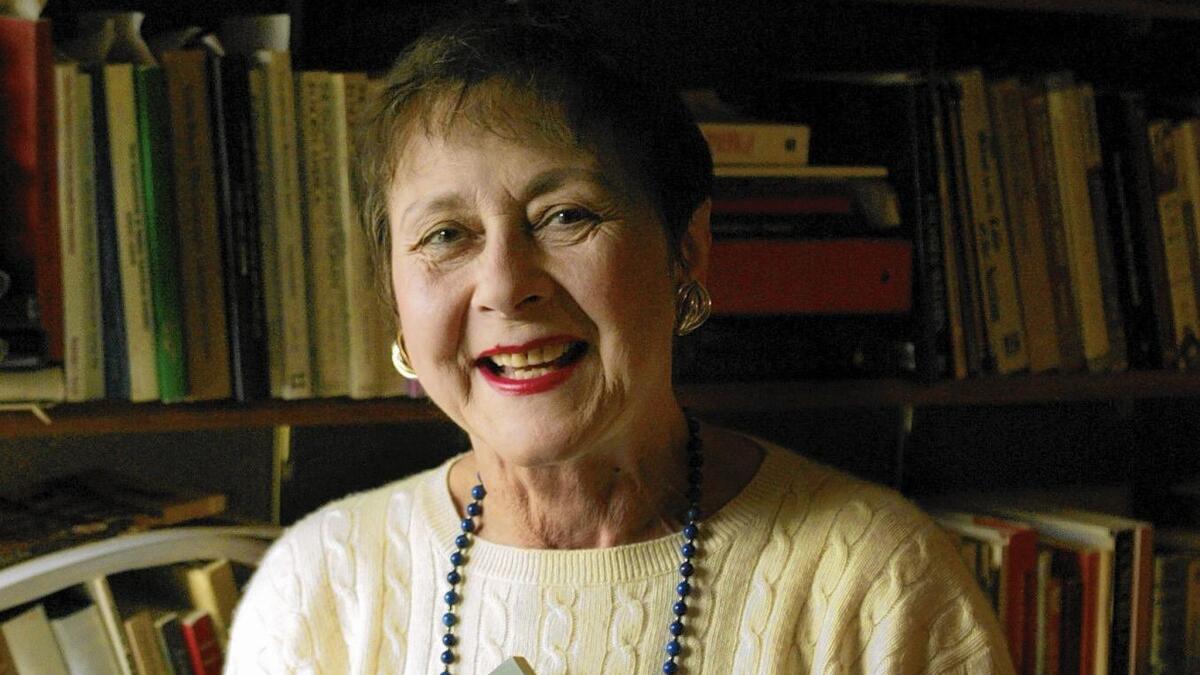Gloria Lothrop dies at 80; historian studied roles of women in American West

- Share via
Gloria Ricci Lothrop, a California historian who studied domestic crafts, cookbooks, letters, tombstones and other artifacts to uncover the roles women played in the development of the American West, died Feb. 2 in Arcadia. She was 80.
Lothrop had chronic obstructive pulmonary disease and pneumonia, said her friend, Cecilia Rasmussen, a former Times staff writer.
A former high school teacher and longtime Pasadena resident, Lothrop spent most of her career teaching at Cal Poly Pomona and Cal State Northridge, where she became the first W.P. Whitsett Professor of California History in 1994. She held that post until her retirement in 2004.
When she began her research in the 1970s, she discovered that the topic of women in the Old West was territory few scholars had explored. The textbook she used at Cal Poly during that period, for instance, devoted only two and a half of its more than 1,000 pages to notable women — and they were largely “shady ladies” and other outlaws.
“Many of the early Western historians were male writers,” Lothrop, who later co-wrote one of the first books to survey the contributions of women to the westward movement, told The Times in 1987. “They wrote about what they knew and what they considered important from their frame of reference. They went to the most accessible records, using treaties of war, business records, court proceedings and legislative proceedings,” accounts that rendered women virtually invisible.
Lothrop turned to other sources, combing attics for items like cookbooks and mementos tucked into old family Bibles. Some valuable material, including women’s diaries and letters, had been buried in collections indexed under a man’s name.
“She had an eye for what is common now but was unusual then, which was using cultural artifacts” to tell women’s history, said Joan M. Jensen, who collaborated with Lothrop on the book “California Women: A History” (1987).
“Our professors told us there was no women’s history because there were no sources,” said Jensen, professor emeritus at New Mexico State University. “We knew there were sources. … We put together something that hadn’t been done before.”
One reason women’s lives were overlooked was that some women pretended to be men. Among those Lothrop wrote about was Willie Matthews, who worked for months as a cowboy on the westward trail until someone discovered she was not a man. The same was true of Charlie Pankhurst, whose masquerade enabled her to work as a stagecoach driver. Lothrop also discovered Mary Miller, who captained steamboats on the Mississippi River, and Mary O’Keefe, a homesteader who herded cattle.
Lothrop’s ancestry led to another deep interest: the history of Italian Americans in the West. In the late 1990s she spearheaded an effort to preserve a shrine built near downtown Los Angeles in the early 1900s by Mother Francis Xavier Cabrini, the first U.S. citizen to be declared a saint by the Catholic Church. She also studied Italian Americans’ land ownership in downtown L.A. and was involved in efforts to save the Italian Hall at Olvera Street.
“She invested a lot in Los Angeles history. She had a strong preservationist tone to her interests,” said Tom Andrews, special collections research historian at Azusa Pacific University.
Lothrop was born in Los Angeles on Dec. 30, 1934, to parents from Tuscany. Leo Ricci, a bookkeeper, received U.S. citizenship in the 1920s, while his wife, Maria, was in the process of becoming naturalized when World War II began.
Although only 7 when America declared war, Lothrop retained vivid memories of how Italian Americans were treated by the government and later spoke and wrote about their experiences in Los Angeles.
“We were visited every two weeks for 10 months” by FBI agents, Lothrop recalled in The Times in 1995. Her mother, an outspoken columnist for an Italian-language newspaper, was placed on a list of “enemy aliens” along with some 400,000 Italian noncitizens nationwide. “My mother was guilty of being acerbic, witty, critical,” Lothrop said.
Lothrop earned a bachelor’s degree in 1956 and a master’s in 1963 from Immaculate Heart College. At USC, where she received a doctorate in history in 1970, she studied under Doyce Nunis Jr., a leading early California historian with whom she wrote “A Guide to the History of California” (1989).
When she joined Cal Poly in 1970, she was the first woman on its history faculty, according to professor emeritus Ralph Shaffer, who later chaired the department.
Lothrop, who was married at least twice, is survived by a brother, George Ricci.
Twitter: @ewooLATimes
More to Read
Start your day right
Sign up for Essential California for the L.A. Times biggest news, features and recommendations in your inbox six days a week.
You may occasionally receive promotional content from the Los Angeles Times.







